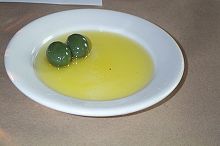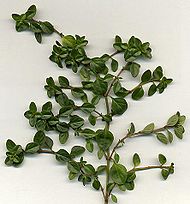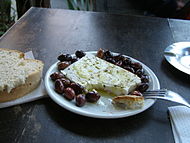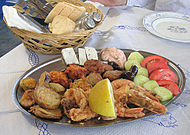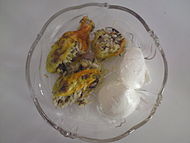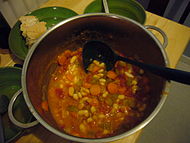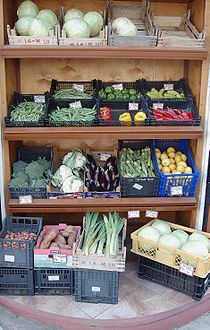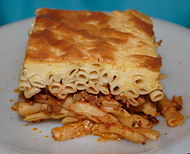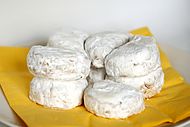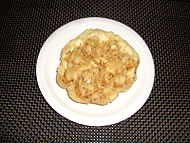- Greek cuisine
-
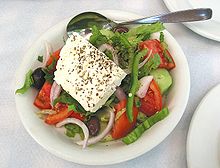 Classic Greek salad
Classic Greek salad
 Traditional Greek taverna, integral part of Greek culture and cuisine.
Traditional Greek taverna, integral part of Greek culture and cuisine.
Greek cuisine (Greek: ελληνική κουζίνα) is a Mediterranean cuisine,[1] sharing characteristics with the cuisines of Italy, the Balkans, Turkey, and the Levant. Contemporary Greek cookery makes wide use of olive oil, vegetables and herbs, grains and bread, wine, fish, and various meats, including poultry, rabbit and pork. Also important are olives, cheese, eggplant (aubergine), courgette, and yoghurt. Greek desserts are characterized by the dominant use of nuts and honey. Some dishes use filo pastry.
Mezés (μεζές) is a collective name for a variety of small dishes, typically served with wines or anise-flavored liqueurs as ouzo or homemade tsipouro. Orektika is the formal name for appetizers and is often used as a reference to eating a first course of a cuisine other than Greek cuisine. Dips are served with bread loaf or pita bread. In some regions, dried bread (paximadhi) is softened in water.
Contents
History
Main articles: Ancient Greek cuisine and Byzantine cuisine Fresh fish, one of the favourite dishes of the Greeks; platter with red figures, c.350–325 BC, Louvre.
Fresh fish, one of the favourite dishes of the Greeks; platter with red figures, c.350–325 BC, Louvre.
Greek cuisine has a long tradition and its flavours change with the season and its geography.[2] Greek cookery, historically a forerunner of Western cuisine, spread its culinary influence - via ancient Rome - throughout Europe and beyond.[3] It has influences from the different people's cuisine the Greeks have interacted with over the centuries, as evidenced by several types of sweets and cooked foods.
It was Archestratos in 320 B.C. who wrote the first cookbook in history. Greece has a culinary tradition of some 4,000 years.[4] Ancient Greek cuisine was characterized by its frugality and was founded on the "Mediterranean triad": wheat, olive oil, and wine, with meat being rarely eaten and fish being more common.[5] This trend in Greek diet continued in Roman and Ottoman times and changed only fairly recently when technological progress has made meat more available. Wine and olive oil have always been a central part of it and the spread of grapes and olive trees in the Mediterranean and further afield is not uncorrelated with Greek colonization.[6][7]
The Byzantine cuisine was similar to the classical cuisine including however new ingredients that were not available before, like caviar, nutmeg and lemons, with fish continuing to be an integral part of the diet. Culinary advice was influenced by the theory of humors, first put forth by the ancient Greek doctor Claudius Aelius Galenus.[8] Byzantine cuisine benefited from Constantinople’s position as a global hub of the spice trade.[9]
Overview
 Dried oregano for culinary use.
Dried oregano for culinary use.
The most characteristic and ancient element of Greek cuisine is olive oil, which is frequently used in most dishes. It is produced from the olive trees prominent throughout the region, and adds to the distinctive taste of Greek food. The basic grain in Greece is wheat, though barley is also grown. Important vegetables include tomato, aubergine (eggplant), potato, green beans, okra, green peppers, and onions. Honey in Greece is mainly honey from the nectar of fruit trees and citrus trees: lemon, orange, bigarade (bitter orange) trees, thyme honey, and pine honey from conifer trees. Mastic (aromatic, ivory coloured resin) is grown on the Aegean island of Chios.
Greek cuisine uses some flavorings more often than other Mediterranean cuisines do, namely: oregano, mint, garlic, onion, dill and bay laurel leaves. Other common herbs and spices include basil, thyme and fennel seed. Persillade is also used as a garnish on some dishes. Many Greek recipes, especially in the northern parts of the country, use "sweet" spices in combination with meat, for example cinnamon and cloves in stews.
The climate and terrain has tended to favour the breeding of goats and sheep over cattle, and thus beef dishes are uncommon. Fish dishes are common in coastal regions and on the islands. A great variety of cheese types are used in Greek cuisine, including Feta, Kasseri, Kefalotyri, Graviera, Anthotyros, Manouri, Metsovone and Mizithra.
Too much refinement is generally considered to be against the hearty spirit of the Greek cuisine, though recent trends among Greek culinary circles tend to favour a somewhat more refined approach.
Dining out is common in Greece, and has been for quite some time. The Taverna and Estiatorio are widespread, serving traditional Greek home cooking at affordable prices to both locals and tourists. Recently, fast-food has also become more popular in Greece and Europe, with local chains such as Goody's springing up, but the McDonald's have mainly closed down. Although fast food is gaining popularity and many major fast-food chains have opened all over Greece, the Greek people still rely primarily on the rich and extensive repertoire of Greek cuisine. In addition, some traditional Greek foods, especially souvlaki, gyros, pita such as tyropita and spanakopita (respectively, cheese and spinach pie) are often served in fast food style.
Origins
Greece has an ancient culinary tradition dating back several millennia, and over the centuries Greek cuisine has evolved and absorbed numerous influences and influenced many cuisines itself.
Some dishes can be traced back to ancient Greece: lentil soup, fasolada, retsina (white or rosé wine flavored with pine resin) and pasteli (candy bar with sesame seeds baked with honey);[10] some to the Hellenistic and Roman periods: loukaniko (dried pork sausage); and Byzantium: feta cheese, avgotaraho (cured fish roe) and paximadi (traditional hard bread baked from corn, barley and rye). There are also many ancient and Byzantine dishes which are no longer consumed: porridge as the main staple, fish sauce, and salt water mixed into wine.
Many dishes are part of the larger tradition of Ottoman cuisine and their names reveal Arabic, Persian or Turkish roots: moussaka, tzatziki, yuvarlakia, keftethes, boureki, and so on. Many dishes' names probably entered the Greek vocabulary during Ottoman times, or earlier in contact with the Persians and the Arabs. Some dishes may be pre-Ottoman, only taking Turkish names later; Ash and Dalby, for example, speculate that grape-leaf dolmathes were made by the early Byzantine period.[11][12]
Regions
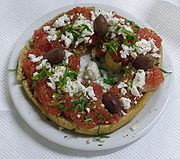 Dakos, traditional Cretan salad.
Dakos, traditional Cretan salad.
Distinct from the main stream regional cuisines are:
- Kritiki
- Kypriaki
- Ionian islands
- Ipeirotiki
- Macedonitiki
- Politiki, from the tradition of the Greeks of Konstantinoupoli / Istanbul
- Pontiaki, found anywhere there are Pontians (Greek immigrants from the Black Sea region, from the 1924 exchange of populations)
- Mikrasiatiki, from the Greek refugess of the 1922 population exchange.
Typical dishes
Greek cuisine is very diverse and although there are many common characteristics amongst the culinary traditions of different regions within the country, there are also many differences, making it difficult to present a full list of representative dishes. For example, the vegetarian dish " Chaniotiko Boureki" (oven baked slices of potatoes with zucchini, myzithra cheese and mint) is a typical dish in western Crete, in the region of Chania. A family in Chania may consume this dish 1-2 times per week in the summer season. However, it is not cooked in any other region of Greece. Many food items are wrapped in Filo pastry, either in bite-size triangles or in large sheets: kotopita (chicken), spanakotyropita (spinach and cheese), chortopita (greens), kreatopita (meat pie, using minced meat), etc.
The list will present some of the most representative Greek dishes that can be found throughout the country and the most famous of the local ones:
Appetizers
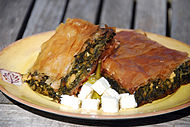 Spanakopita with cubed feta.
Spanakopita with cubed feta.
Meze (appetizer; plural mezedes) is served in restaurants called mezedopoleía, served to complement drinks, and in similar establishments known as tsipourádika or ouzerí (a type of café that serves drinks such as ouzo or tsipouro). A tavérna (tavern) or estiatório (restaurant) also offers a meze as an orektikó (appetiser). Many restaurants offer their house pikilía (variety) a platter with a smorgasbord of various mezedes that can be served immediately to customers looking for a quick or light meal. Hosts commonly serve mezedes to their guests at informal or impromptu get-togethers as they are easy to prepare on short notice. Krasomezédhes (literally "wine-meze") are mezedes that go well with wine; ouzomezédhes are mezedes that go with ouzo.
- Deep-fried vegetables "tiganita" (courgettes, aubergines, peppers, zucchini, or mushrooms).
- Dakos, a Cretan salad consisting of a slice of soaked dried bread or barley rusk (paximadi) topped with chopped tomatoes and crumbled feta or mizithra cheese.
- Dolmadakia (from Turkish dolma): grapevine leaves stuffed with rice and vegetables; meat is also often included.
- Fava: purée of yellow split peas or beans; sometimes made of fava beans (called κουκιές in Greek).
- Garides: shrimps.
- Gavros: european anchovy.
- Greek Salad: the so-called Greek salad is known in Greece as village/country salad (horiatiki) and is essentially a tomato salad with cucumber, red onion, feta cheese, and kalamata olives, dressed with olive oil. In Cyprus it contains also cracked wheat (bulgur), spring onions instead of red onions, and lemon juice.
- Horta: wild or cultivated greens, steamed or blanched and made into salad, simply dressed with lemon juice and olive oil. They can be eaten as a light meal with potatoes (especially during Lent, in lieu of fish or meat).
- Kalamarakia: squid.
- Kolokythakia: zucchini.
- Kolokythoanthoi: zucchini flowers stuffed with rice or cheese and herbs.
- Koukies: fava beans.
- Lachanosalata: cabbage salad. Very finely shredded cabbage with salt, olive oil, lemon juice/vinegar dressing.
- Kroketes: croquettes.
- Marides tiganites: deep-fried whitebait, usually served with lemon wedges.
- Melitzanes, eggplants.
- Melitzanosalata: aubergine (eggplant) salad; looks like potato salad.
- Pantzarosalata: beetroot salad with olive oil and vinegar.
- Patatosalata: potato salad with olive oil, finely sliced onions, mayonnaise, lemon juice or vinegar.
- Saganaki: fried yellow cheese, usually graviera cheese; the word "saganaki" means a small cooking pan, is used to say "fried" and can be applied to many other foods.
- Skordalia: thick garlic and potato puree, usually accompanies deep fried fish/cod (bakaliaro me skordo, i.e. fried battered cod with garlic dip, a very popular dish).
- Spanakopita: spinach, feta cheese (sometimes in combination with ricotta cheese), onions or spring onions, egg and seasoning wrapped in phyllo pastry in a form of a pie.
- Taramosalata (from Turkish tarama, roe): fish roe mixed with boiled potatoes or moistened breadcrumbs, olive oil and lemon juice.
- Tzatziki (from Turkish cacık): yoghurt with cucumber and garlic puree, used as a dip.
- Tyropita: a white-cream cheese (usually mizithra) pie with phyllo pastry.
Soups
- Bourou-Bourou, a vegetable & pasta soup from the island of Corfu.
- Fakes, is a lentil soup and one of the famous everyday Greek soups, usually served with vinegar and olives.
- Fasolada, a bean soup defined in many cookery books as the traditional Greek dish, sometimes even called "the "national food of the Greeks".[13] It is made of beans, tomatoes, carrot, celery and a generous amount of olive oil usually served witha variety of salty side dishes.
- Kotosoupa, a lemon chicken soup.
- Magiritsa, is the traditional Easter soup made with lamb offal and thickened with avgolemono.
- Patsas, a tripe soup, surprisingly considered a good breakfast.
- Psarosoupa or 'fish soup' can be cooked with a variety of fish types, and several kinds of vegetables (carrots, parsley, celery, potatoes, onion), several varieties include the classic kakavia which is drizzled with olive oil.
- Revithia, a chickpea soup.
- Trahana soup, a mixture of fermented grain.
Vegetarian main dishes
Traditional vegetable market in Athens.
Very popular during fasting periods, such as the Great Lent:
- Aginares a la Polita: artichokes with olive oil.
- Arakas me aginares: oven-baked fresh peas with artichokes.
- Bamies: okra with tomato sauce (sometimes with potatoes or during non-fasting times with chicken/lamb).
- Briám: an oven-baked ratatouille of summer vegetables based on sliced potatoes and zucchini in olive oil. Usually includes eggplant, tomatoes, onions, and ample aromatic herbs and seasonings.
- Domatokeftedes: tomato fritters with mint, fried in olive oil and typically served with fava (split-pea paste). Mainly a Cycladic island dish.
- Fasolakia: fresh green beans stewed with potatoes, zucchini and tomato sauce.
- Gemista, baked stuffed vegetables. Usually tomatoes, peppers, or other vegetables hollowed out and baked with a rice-and-herb filling or minced meat.
- Gigandes plaki: baked beans with tomato sauce and various herbs.[14] Often made spicy with various peppers.
- Horta (greens), already mentioned in the appetizers section, are quite often consumed as a light main meal, with boiled potatoes and bread.
- Kinteata, dish made from boiled young nettles.
- Lachanodolmades: cabbage rolls, stuffed with rice and sometimes meat, spiced with various herbs and served with avgolemono sauce or simmered in a light tomato broth.
- Lachanorizo, cabbage with rice.
- Prassorizo, leeks with rice.
- Spanakorizo, spinach and rice stew cooked in lemon and olive-oil sauce.
Meat and seafood dishes
- Apáki: a famous Cretan specialty; lean pork marinated in vinegar, then smoked with aromatic herbs and shrubs, and packed in salt.
- Astakos: lobster.
- Astakomacaronada: spaghetti with lobster.
- Chtapodi sti schara: grilled octopus in vinegar, oil and oregano. Accompanied by ouzo.
- Giouvetsi: lamb or veal baked in a clay pot with kritharaki (orzo) and tomatoes.
- Gyros: meat roasted on a vertically turning spit and served with sauce (often tzatziki) and garnishes (tomato, onions) on pita bread; a popular fast food.
- Kleftiko: literally meaning "in the style of the Klephts", this is lamb slow-baked on the bone, first marinated in garlic and lemon juice, originally cooked in a pit oven. It is said that the Klephts, bandits of the countryside who did not have flocks of their own, would steal lambs or goats and cook the meat in a sealed pit to avoid the smoke being seen.
- Keftedakia, fried meatballs .
- Macaronada: classic spaghetti.
- Moussaka (from Arabic مسقعة musaqqa'): an oven-baked layer dish: ground meat and eggplant casserole, topped with a savory custard which is then browned in the oven. There are other variations besides eggplant, such as zucchini or rice, but the eggplant version, melitzánes moussaká is by far the most popular. The papoutsákia ("little shoes") variant is essentially the same dish, with the meat and custard layered inside hollowed, sauteéd eggplants.
- Mydia: mussels.
- Oven-baked lamb with potatoes (Αρνί στο φούρνο με πατάτες). One of the most common "Sunday" dishes. There are many variations with additional ingredients.
- Paidakia: grilled lamb chops with lemon, oregano, salt and pepper.
- Pastitsio: an oven-baked layer dish: Bechamel sauce top, then pasta in the middle and ground meat cooked with tomato sauce at the bottom.
- Pork with celery (hirino me selino/hirino selinato).
- Soutzoukakia Smyrneika (Smyrna meatballs): long shaped meatballs with cumin, cinnamon and garlic and boiled in tomato sauce with whole olives. Often served with rice or mashed potatoes.
- Souvlaki: (lit: 'skewer') grilled pork small pieces or gyros, tomatoes, onions and tzatziki as sauce all wrapped with pita considered as fast food.
- Spetsofai: a stew of country sausage, green mild peppers, onions and wine. Originates from Pelion.
- Stifado: rabbit or hare stew with pearl onions, vinegar, red wine and cinnamon. Beef can be substituted for game.
- Xiphias: swordfish.
- Yiouvarlakia: meatballs soup with egg-lemon sauce.
Quick meals
Meals using easily available (usually seasonal) and inexpensive ingredients, with little preparation involved.
- Strapatsada: eggs scrambled in olive oil and fresh tomato puree, seasoned with salt, pepper and oregano. Often includes feta cheese.
Desserts and sweets
Diples made on an iron mould dipped in batter and cooked in cooking oil.
 Yogurt with honey.
Yogurt with honey.
- Amygdalotá or pastéli exist in many varieties throughout Greece and Cyprus, and are especially popular in the islands. They consist of powdered blanched almonds, confectioner's sugar and rose water, molded in various shapes and sizes. They are snow-white and are considered wedding and baptismal desserts.
- Finikia, cookie topped with chopped nuts.
- Baklava, phyllo pastry layers filled with nuts and drenched in honey.
- Diples, a Christmas and wedding delicacy, made of paper-thin, sheet-like dough which is cut in large squares and dipped in a swirling fashion in a pot of hot olive oil for a few seconds. As the dough fries, it stiffens into a helical tube; it is then removed immediately and sprinkled with honey and crushed walnuts.[15]
- Galaktoboureko, custard baked between layers of phyllo, and then soaked with lemon-scented honey syrup. The name derives from the Greek "gala"(γάλα), meaning milk, and from the Turkish börek, meaning filled, thus meaning "filled with milk."
- Halva, a nougat of sesame with almonds or cacao.
- Karydopita, a cake of crushed walnuts, soaked or not in syrup.
- Koulourakia, butter or olive-oil cookies.
- Kourabiedes, Christmas cookies made by kneading flour, butter and crushed roasted almonds, then generously dusted with powdered sugar.
- Loukoumades, similar to small crusty donuts, loukoumades are essentially fried balls of dough drenched in honey and sprinkled with cinnamon.
- Loukoumi is a confection made from starch and sugar, essentially similar to the Turkish delight. A variation from Serres is called Akanés. Loukoúmia are flavored with various fruit flavors, with rose water considered the most prized.
- Melomakarona, "honey macaroons", Christmas cookies soaked with a syrup of diluted honey (méli in Greek) and then sprinkled with crushed walnuts.
- Milopita, apple pie with cinnamon and powdered sugar.
- Moustalevria, a flour and grape must flan.
- Moustokouloura, cookies of flour kneaded with fresh grape juice (must) instead of water.
- Rizogalo ("rice-milk") is rice pudding.
- Spoon sweets (γλυκά του κουταλιού) of various fruits, ripe or unripe, or green unripe nuts. Spoon sweets are essentially marmalade except that the fruit are boiled whole or in large chunks covered in the fruit's made syrup.
- Tsoureki, a traditional Christmas and Easter sweet bread also known as 'Lambropsomo' (Easter bread), flavored with "mahlepi", the intensely aromatic extract of the stone of the St. Lucie Cherry.
- Vasilopita, Saint Basil's cake or King's cake, traditional only for New Year's Day. Vasilopites are baked with a coin inside, and whoever gets the coin in their slice are considered blessed with good luck for the whole year.
- Yogurt with honey or spoon sweet syrup.
Cheese
 Feta cheese.
Feta cheese.
There is a wide variety of cheeses made in various regions across Greece. The vast majority of them remain unknown outside the Greek borders due to the lack of knowledge and the highly localized distinctive features. Many artisanal, hand made cheeses, both common varieties and local specialties, are produced by small family farms throughout Greece and offer distinct flavors atypical of the mass produced varieties found commercially in Greece and abroad. A good list of some of the varieties of cheese produced and consumed in Greece can be found here. These are some of the more popular throughout Greece:
- Kefalotyri
- Kefalograviera
- Graviera
- Myzithra
- Anthotyros
- Formaela
Drinks
- Greek frappé coffee, a foam-covered drink derived from spray-dried instant coffee that is consumed cold.
- Turkish coffee, made by boiling finely ground coffee beans, and is served thick and strong, and often sweetened. It is always unfiltered, with the coffee sediment at the bottom of the cup.
- Wine is the most common drink in Greece. Legend claims that wine was invented on the island of Icaria.
- Beer includes a wide variety; common brands include Vergina, Heineken, Amstel, Zeos, Mythos, Alfa Hellenic Lager, Fix Hellas, Henninger and Kaiser, all of which are produced locally, some under license.
- Ouzo (an 80-proof clear alcoholic beverage that is flavored with anise; it turns milky white with water or ice; the best said to be produced on the island of Lesbos).
- Tsipouro or (esp. in Crete) tsikoudia/raki, mostly home-brewed, a clear drink similar to ouzo, often with higher alcohol content, and usually not flavored with herbs. The city of Volos at the centre of Greece is well known for its tsipouradika (literally: tsipouro places). In Thessaly tsipouro is always flavored with anise.
- Retsina (a white wine that has some pine resin added, originally as a preservative, but nowadays for the flavor; this is an Athens region specialty. It should not be aged.).
- Mavrodafni, sweet, liquor-style, red wine with higher alcohol percentage than normal.
- Metaxa, a brand of sweet brandy, 40% alcohol content.
- Tentura, a cinnamon flavored liquor from Patras.
- Mastichato, liquor seasoned with mastic, a resin gathered from the mastic tree.
See also
- List of Greek dishes
- Greek food products
- Cuisine of Cyprus
- Greek Macedonian cuisine
- Cuisine of the Mediterranean
- Cretan diet
References
- Andrew Dalby, Siren Feasts: A History of Food and Gastronomy in Greece, London, 1996. ISBN 0-415-11620-1. (Mostly about ancient and Byzantine food.)
- Tess Mallos, Greek Cookbook, New South Wales, Australia, 1979. ISBN 0-7271-0287-7.
Notes
- ^ Spices and Seasonings:A Food Technology Handbook - Donna R. Tainter, Anthony T. Grenis, p. 223
- ^ Armstrong, Kate; Hellander, Paul (2006). Lonely Planet Greece. Hawthorn, Vic., Australia: Lonely Planet Publications. p. 76. ISBN 1-74059-750-8.
- ^ Mallos, Tess (1979). Greek Cookbook. Dee Why West, NSW., Australia: Summit Books. p. inside cover. ISBN 0-7271-0287-7.
- ^ http://www.focusmm.com/greece/gr_coumn.htm - Historical reference about Ancient Greek cuisine.
- ^ Renfrew, Colin (1972). The Emergence of Civilization; The Cyclades and the Aegean in the Third Millennium B.C.. Taylor & Francis. p. 280.
- ^ Katz, Solomon H.; McGovern, Patrick; Fleming, Stuart James (2000). Origins and Ancient History of Wine (Food and Nutrition in History and Anthropology). New York: Routledge. p. x. ISBN 90-5699-552-9.
- ^ Wilson, Nigel Guy (2006). Encyclopedia of ancient Greece. New York: Routledge. p. 27. ISBN 0-415-97334-1.
- ^ Civitello, Linda (2007). Cuisine and Culture: A History of Food and People. New York: Wiley. p. 67. ISBN 0-471-74172-8.
- ^ Kiple, Kenneth F. (2007). A movable feast: ten millennia of food globalization. Cambridge, UK: Cambridge University Press. p. 95. ISBN 0-521-79353-X.
- ^ greekcuisine
- ^ Dalby, p.190
- ^ John Ash, A Byzantine Journey
- ^ Λεξικό της κοινής Νεοελληνικής, 1998
- ^ Gigantes/Yiyantes (Greek Giant Baked Beans)
- ^ Diples (Thiples) (Honey Rolls) Greek Dessert
Cheeses Anthotyros · Feta · Graviera · Kasseri · Kefalotyri · Kefalograviera · Formaela · Myzithra · Manouri · Metsovone · Metsovela · Xynotyro · Xynomizithra · HalloumiDishes Aginares a la Polita · Astakos · Arakas me aginares · Avgolemono · Astakomacaronada · Baked lamb with potatoes · Bamies · Briám · Fakes · Fasolada · Fasolakia · Gemista · Giouvetsi · Gigandes plaki · Gyros · Hilopites · Kotosoupa · Keftedakia · Kokoretsi · Lachanorizo · Loukaniko · Macaronada · Magiritsa · Manestra · Moussaka · Mydia · Paidakia · Pastitsio · Pork with celery · Psarosoupa · Revithia · Soutzoukakia Smyrneika · Souvlaki · Souvla · Spanakorizo · Spetsofai · Stifado · Strapatsada · XiphiasDesserts Amygdalotá · Bougatsa · Cake · Copenhagen (dessert) · Diples · Finikia · Galaktoboureko · Galatopita · Glika tou koutaliou · Granita · Halvas · Karydopita · Koulourakia · Kourabiedes · Loukoumades · Soutzouki · Loukoumi · Melomakarona · Milopita · Moustalevria · Moustokouloura · Profiterole · Rizogalo · Tsoureki · Tulumba · Vasilopita · Yoghurt with honey and walnutsDrinks Wine · Beer · Frappé coffee · Greek coffee (Turkish/Arabic) · Diktamo · Kitron · Metaxa · Mavrodafni · Ouzo · Retsina · Mastichato · Soumada · Tsipouro · Tsikoudia · Tentura · Kumquat · ZivaniaEuropean cuisine Sovereign
states- Albania
- Andorra
- Armenia
- Austria
- Azerbaijan
- Belarus
- Belgium
- Bosnia and Herzegovina
- Bulgaria
- Croatia
- Cyprus
- Czech Republic
- Denmark
- Estonia
- Finland
- France
- Georgia
- Germany
- Greece
- Hungary
- Iceland
- Ireland
- Italy
- Kazakhstan
- Latvia
- Liechtenstein
- Lithuania
- Luxembourg
- Macedonia
- Malta
- Moldova
- Monaco
- Montenegro
- Netherlands
- Norway
- Poland
- Portugal
- Romania
- Russia
- San Marino
- Serbia
- Slovakia
- Slovenia
- Spain
- Sweden
- Switzerland
- Turkey
- Ukraine
- United Kingdom
- (England
- Northern Ireland
- Scotland
- Wales)
- Vatican City
States with limited
recognition- Abkhazia
- Kosovo
- Nagorno-Karabakh Republic
- Northern Cyprus
- South Ossetia
- Transnistria
Dependencies
and other territories- Åland
- Faroe Islands
- Gibraltar
- Guernsey
- Jan Mayen
- Jersey
- Isle of Man
- Svalbard
Cuisine of the Mediterranean Northern Africa Southern Europe European regions Western Asia Categories:
Wikimedia Foundation. 2010.

